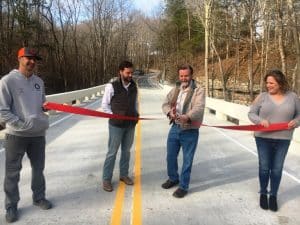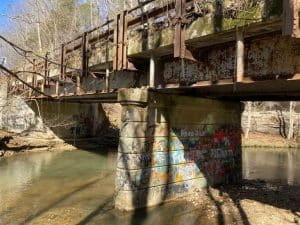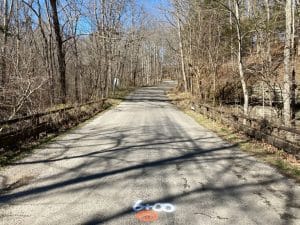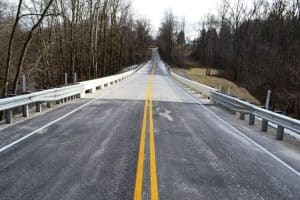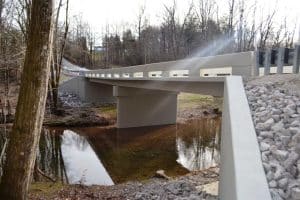December 22, 2022
By: Dwayne Page
Now Open!
After seven months, motorists traveling Big Rock Road no longer have to detour because the new bridge over Pine Creek is now completed.
(View photos of old Big Rock Road Bridge at link below)
https://www.dropbox.com/sh/xedh0gdzu0lmmu6/AAD4YaS79bSKyY9yy_K9JTmba?dl=0
(View photos of new Big Rock Road Bridge at link below)
https://www.dropbox.com/sh/chlivw0pwz6evko/AABH54a_n9ex_17r3waPybrAa?dl=0
Road Supervisor Danny Hale held a ribbon cutting at the bridge Wednesday afternoon accompanied by his secretary Rena Willoughby; the Project Engineer, Kyle Hazel of Hazel Engineering, LLC in Cookeville; and Project Manager Justin Garmany of Dement Construction in Jackson.
Construction began on the new bridge in May and was finished on Tuesday, December 20.
The price tag for the bridge was $1,554,000 but the good news is no local tax dollars were needed to fund it. The state picked up the tab under the state’s IMPROVE Act high priority bridge replacement program.
Although he and his staff did not have to take on the work themselves, Road Supervisor Hale’s involvement was necessary in the planning for the project because the state originally had other ideas.
“Not long after I took office in 2018, they (state) wanted me to spend about $1.1 million to replace a bridge over old Dry Creek Road near Dowelltown but I felt like that was a waste of money because there is no traffic on that portion of Dry Creek Road. Years ago, before I took office, I built an access road through there for then Road Supervisor Kenny Edge, which tied back into Highway 70 from Old Dry Creek Road plus farther down there was another access road, so this bridge really no longer served a purpose. I got with my engineer, and we asked the state to let us redirect the money earmarked for the Dry Creek Road Bridge to the Big Rock Road bridge over Pine Creek because it too was designated by the state as a high priority bridge with an efficiency rating of 51.1% but it has much more traffic on it than the Dry Creek Bridge,” said Road Supervisor Hale.
At first, Hale said the state only wanted to make repairs to the Big Rock Road Bridge instead of an outright replacement, but he convinced them otherwise.
“They (state) had sent me something saying they wanted me to put a new floor in it and rails on it but that was going to cost about $800,000 and it would still have had the old under structure. I couldn’t see doing a patch job when later it would have had to be torn out again with a new under structure put in. It was about two years in the making but they (state) eventually let me swap bridges in the program,” said Hale.
According to Road Supervisor Hale the new two-lane bridge with a weight limit of 40 tons has a state rated life expectancy of 75 to 100 years. The bridge it replaced had a weight limit of eight tons.
Hale praised the project engineer and contractor for their work and cooperation.
“I want to commend them for the timely manner in which the bridge was built and for their craftsmanship. There were no flaws. It didn’t matter when I went over there to check on them, they never needed anything from me. They were always making progress,” said Road Supervisor Hale.
The Tennessee IMPROVE Act of 2017 included a list of 526 local bridges across the state in need of repair. These bridges were identified by the Tennessee Department of Transportation based on bridge inspection reports, which are updated every two years. It is the intent of the Department to address all of these bridges within 14 years. In order to do so, this program was created to prioritize and rehabilitate or replace these local bridges.
Eligible Activities:
The High Priority Bridge Replacement Program (HPBRP), per TCA § 54-4-601, provides funding for priority bridges not located on the State system of highways, known as off-system bridges, for local governments meeting the eligibility requirements in TCA § 54-4-504(c).
“Bridge” means a structure on a public road, including supports, erected for carrying traffic over a depression or an obstruction, such as water or a highway or railway, and having an opening measured along the center of the roadway of more than twenty feet (20′) between under-copings of abutments or spring lines of arches, or extreme ends of openings for multiple boxes; it may also include multiple pipes, where the clear distance between openings is less than half of the smaller contiguous opening. Potentially eligible bridges are prioritized by the Department
Funding:
This program can pay up to 100% of the total project cost. It can be used alone or in combination with other bridge programs to rehabilitate or replace offsystem bridges in Tennessee.
1990 State Bridge Grant Program. In order to be eligible for the 100% state HPBRP funding, a county must use at least 33% worth of 1990 State Bridge Grant funds for a bridge on the IMPROVE Act list first. After 33% of a fourteen-year allocation has been committed to a bridge project, the HPBRP can be used to fund the remainder of the project and other bridge projects on the IMPROVE Act list.




